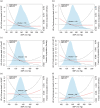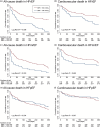Correlation between systolic blood pressure and mortality in heart failure patients with hypertension
- PMID: 38406922
- PMCID: PMC11064921
- DOI: 10.1097/HJH.0000000000003693
Correlation between systolic blood pressure and mortality in heart failure patients with hypertension
Abstract
Background: The correlation between systolic blood pressure (SBP) and mortality in hypertensive patients with different phenotypes of heart failure (HF) has not been adequately studied, and optimal blood pressure control targets remain controversial. To explore the link between SBP and prognosis in all or three ejection fraction (EF) phenotypes of HF patients with hypertension.
Methods: We analyzed 1279 HF patients complicated by hypertension in a retrospective cohort. The SBP <130 mmHg group included 383 patients, and the SBP ≥130 mmHg group included 896 patients. The major end point was all-cause mortality.
Results: Of the 1279 study patients, with a median age of 66.0 ± 12.0 years, 45.3% were female. The proportions of the three subtypes of heart failure complicated with hypertension (HFrEF, HEmrEF, and HFpEF) were 26.8%, 29.3%, and 43.9%, respectively. During the 1-year follow-up, 223 patients experienced all-cause death, and 133 experienced cardiovascular death. Restricted cubic splines showed that the risk of all-cause and cardiovascular death increased gradually as the SBP level decreased in patients with HFrEF and HFmrEF. Furthermore, the multivariate Cox proportional hazards model revealed that SBP <130 mmHg was also associated with an increased risk of all-cause death [hazard ratio (HR) 2.53, 95% confidence interval (CI) 1.23-5.20, P = 0.011] and cardiovascular death (HR 1.91, 95% CI 1.01-3.63, P = 0.047) in HFrEF patients. A trend toward increased risk was observed among HFmrEF patients, but it was not statistically significant. This trend was not observed in HFpEF patients.
Conclusion: In HFrEF patients, SBP <130 mmHg was associated with an increased risk of all-cause and cardiovascular mortality. A trend toward increased risk was observed among HFmrEF patients, but not among HFpEF patients.
Copyright © 2024 The Author(s). Published by Wolters Kluwer Health, Inc.
Conflict of interest statement
The authors certify that they have no financial conflicts of interest.
Figures



Similar articles
-
Etiology of Heart Failure Across the Ejection Fraction Spectrum and Association With Prognosis.JACC Heart Fail. 2025 Aug;13(8):102491. doi: 10.1016/j.jchf.2025.03.037. Epub 2025 Jun 16. JACC Heart Fail. 2025. PMID: 40527152
-
Outcomes of KDIGO-Defined CKD in U.S. Veterans With HFpEF, HFmrEF, and HFrEF.JACC Heart Fail. 2025 Mar;13(3):467-479. doi: 10.1016/j.jchf.2024.11.007. Epub 2025 Feb 5. JACC Heart Fail. 2025. PMID: 39918536
-
Association between insulin resistance indices and outcomes in patients with heart failure with preserved ejection fraction.Cardiovasc Diabetol. 2025 Jan 22;24(1):32. doi: 10.1186/s12933-025-02595-x. Cardiovasc Diabetol. 2025. PMID: 39844150 Free PMC article.
-
Sodium-glucose co-transporter 2 inhibitors in heart failure with mildly reduced or preserved ejection fraction: an updated systematic review and meta-analysis.Eur J Med Res. 2022 Dec 29;27(1):314. doi: 10.1186/s40001-022-00945-z. Eur J Med Res. 2022. PMID: 36581880 Free PMC article.
-
Blood pressure targets for hypertension in people with diabetes mellitus.Cochrane Database Syst Rev. 2013 Oct 30;2013(10):CD008277. doi: 10.1002/14651858.CD008277.pub2. Cochrane Database Syst Rev. 2013. PMID: 24170669 Free PMC article.
Cited by
-
Epidemiology and Short-Term Outcomes of Heart Failure With Preserved and Mildly Reduced Ejection Fraction in Colombia: Insights of the Colombian Heart Failure Registry (RECOLFACA).Cardiol Res. 2025 Jun;16(3):267-277. doi: 10.14740/cr2015. Epub 2025 May 7. Cardiol Res. 2025. PMID: 40370625 Free PMC article.
References
-
- Virani SS, Alonso A, Aparicio HJ, Benjamin EJ, Bittencourt MS, Callaway CW, et al. . Heart Disease and Stroke Statistics-2021 update: a report from the American Heart Association. Circulation 2021; 143:e254–e743. - PubMed
-
- Ni H, Xu J. Recent trends in heart failure-related mortality: United States. NCHS Data Brief 2000. –2014; 2015:1–8. - PubMed
Publication types
MeSH terms
LinkOut - more resources
Full Text Sources
Medical
Research Materials
Miscellaneous

